Turtles are essential members of the ecosystem. They are scavengers that help to clean up carrion such as dead fish, and they help to keep aquatic insect populations in check. Turtles also consume snails, and slugs, while others help to limit the numbers of invasive, introduced clams and mussels.
Some turtles and tortoises such as Box turtles help to spread new, native plants by defecating seeds as they wander. In Missouri, there are 18 species of turtles you may find in waters, wetlands, and forests.
All but 3 species are protected in the state of Missouri, and a few such as the Blanding’s turtle, and the Chicken turtle are threatened or endangered. Here is our extensive guide to all the turtles you may find in the Show Me State.
Table of Contents
Turtles in Missouri
1. Blanding’s Turtle
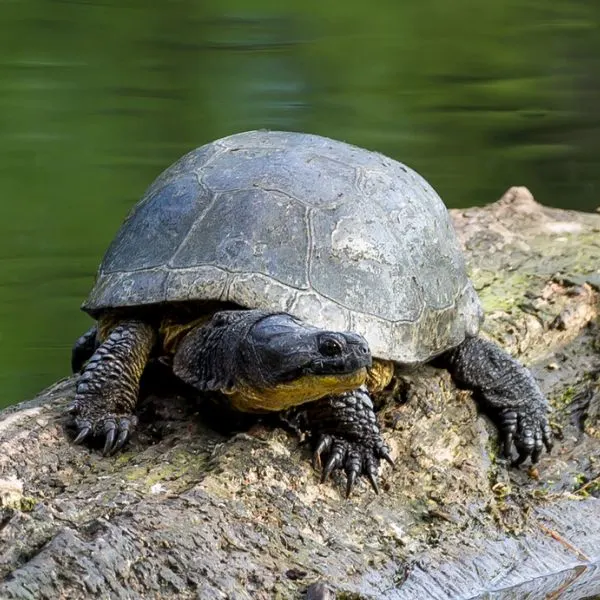
- Experience Level: Intermediate
- Family: Emydidae
- Scientific Name: Emydoidea blandingii
- Other Names: N/A
- Adult Size: 5 to 8 inches (12.5 to 20 cm)
- Life Span: Up to 80 years
- Average Price Range: $300 to $450
- Conservation Status: Endangered
Blanding’s turtles seem to have a permanent smile and were named after American explorer and naturalist William Blanding. These turtles are very rare in Missouri and are only found in 3 western and eastern counties.
Aside from the constant smile, these turtles have domed, dark, oval shells with a lot of faded yellow speckles. Their hinged plastrons are a brighter yellow with black patches, but the brightest yellow is found on the bottom half of the neck and chin.
These turtles enjoy bogs, marshes, drainage ditches, and other wetlands. They will bask in the vegetation and on muskrat houses. In Missouri, Blanding’s turtles are much more aquatic than is observed in other states. Other habitat necessities are abundant vegetation and muddy bottoms.
The diet of these turtles includes frogs, fish, crayfish, aquatic insects, and snails. They also feed on some types of vegetation. These turtles can feed in water and on land, many aquatic turtles have to swallow their food in water because their tongues can’t move.
Cooters in Missouri
2. Eastern River Cooter

- Experience Level: Beginner to Intermediate
- Family: Emydidae
- Scientific Name: Pseudemys concinna concinna
- Other Names: River Cooter
- Adult Size: Between 8 and 12 inches
- Life Span: Between 20 and 40 years
- Average Price Range: $20 to $50
- Conservation Status: Special concern
Eastern River Cooters are brightly colored freshwater turtles that can be found in rivers, reservoirs, and sloughs. (In case you’re like me and don’t know what a slough is, it’s a type of swamp or small lake that is connected to a larger body of water.)
These turtles can be found along Southern Missouri, but they are very shy and will slip into the water at the first sign of disturbances.
You can see them on basking spots in warm weather. They have slightly domed shells that range from olive-green to dark brown, almost black. The carapace (upper part of a turtle’s shell) has a bright pattern of yellow markings that fade as the turtle ages.
They also have a bright yellow plastron (the bottom part of a turtle’s shell). The exposed skin is also dark green to nearly black but has plenty of yellow “racing stripes.” There is usually a Y-shaped mark on the turtle’s neck or head.
Other than basking, River Cooters rarely leave the water. Females will brave dry land to find a proper nesting site. During this time—May through June in MO—watch out for turtles crossing roads, as many meet their doom under the wheels of vehicles.
River Cooters are mainly herbivores, feeding on duckweed, water hyacinth, arrowhead, coontail, and other plants. They may occasionally eat insects and other small invertebrates.
Box Turtles in Missouri
3. Ornate Box Turtle
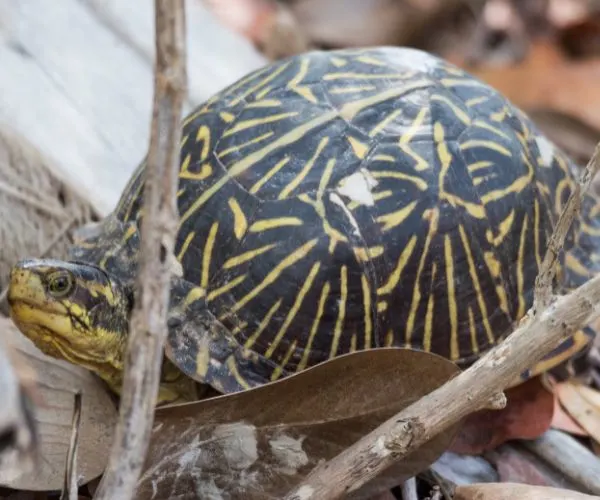
- Experience Level: Intermediate to Expert
- Family: Emydidae
- Scientific Name: Terrapine ornata
- Other Names: Box Tortoise, Western Box Turtle
- Adult Size: 4 to 5 inches (10 to 12.5 cm)
- Life Span: 30 to 40 years
- Average Price Range: $150 to $450
- Conservation Status: Near threatened
Ornate Box turtles are a colorful species that can completely enclose themselves in its shell. Their highly domed carapace is dark with starburst type patterning of yellow or orange. Their skin and scales have light colored speckles, and their plastrons are brown with yellow patches.
You’ll find this turtle in Missouri’s grasslands, prairies, glades, and pastures. Box turtles are terrestrial and don’t spend much time in the water.
These turtles burrow in the ground to overwinter, but very cold, hard winters can be fatal to them if they aren’t deep enough. Roads and people taking these turtles as pets are the biggest threats to these turtles.
Wild box turtles may seem like great pets, but when they are taken from their home and put into captivity, they don’t live long, and will often starve themselves. If you want a pet turtle, please find a quality, reputable breeder. Captive-bred turtles are much more suited to being pets.
The majority of the Ornate Box turtle’s diet is grasshoppers, beetles, and other insects, but they will forage on some berries and tender plants.
4. Three-toed Box Turtle
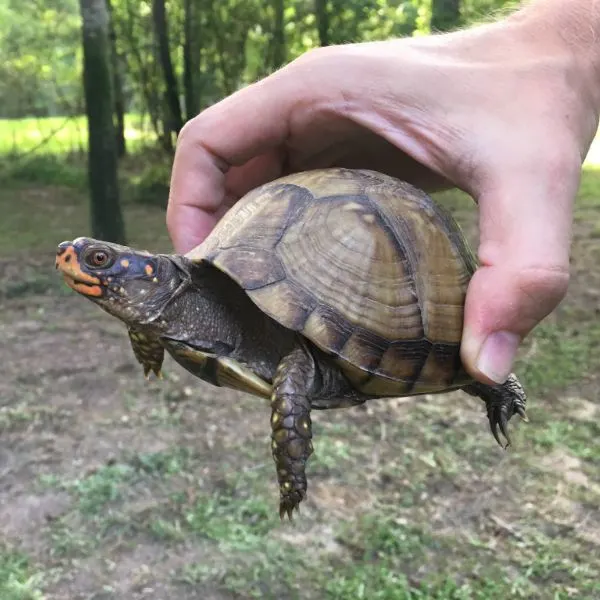
- Experience level: Intermediate
- Family: Emydidae
- Scientific Name: Terrapene carolina triunguis
- Other Names: N/A
- Average Adult Size: 4.5 – 6.5 inches
- Life Span: 70+ years
- Average Price Range: $140 – $430
- Conservation Status: Vulnerable
- Recommended Books: Box Turtles (Complete Herp Care) by Tess Cook
Three-toed Box turtles are found across most areas of Missouri except most of the northern counties. They are a more forest dwelling species and prefer damp woodlands, and can be found along forest edges.
These turtles have a dark brown, domed shell, with a central ridge. They have pale, yellowish, or orange markings on the carapace and a yellow plastron with smudges of brown coloration. Their skin is dark brown to black with yellow or orange blotches.
As their name implies, they have 3 toes on their hind legs, though there are some that have 4. Males have red eyes and a thick tail, while females of this species have yellow-brown eyes and a smaller tail.
Younger Three-toed Box turtles feed mostly on insects, worms, and caterpillars, but adults consume mostly mushrooms, berries, and plant matter.
Chicken Turtles in Missouri
5. Western Chicken Turtle

- Experience Level: Intermediate
- Family: Emydidae
- Scientific Name: Deirochelys Reticularia Miaria
- Other Names: N/A
- Adult Size: Between 4 and 10 inches
- Lifespan: Between 15 and 30 years
- Average Price Range: Between $180 and $300
- Conservation Status: Endangered in Missouri, considered secure nationally
Western Chicken turtles are one of the rarest species in Missouri. They are only found in lowland swamps, ponds, and streams in the extreme southeast area of the state.
These turtles have an oval, egg-shaped shell that ranges from brown to olive and has a pattern that looks like a yellowish net. The plastron is yellow with brownish outlines along the scutes (growth plates on a turtle’s shell).
The Western Chicken turtle has a lot of yellow and green stripes on the head, neck, and limbs. It also has a very long neck.
These turtles are called chicken turtles because when they were hunted for food, people described their taste as “that of a chicken.”
Chicken turtles are omnivores that eat mostly invertebrates such as crayfish, insect larvae, and fishing spiders. They also feed on some plants and algae.
Map Turtles in Missouri
6. Northern Map Turtle

- Experience Level: Beginner
- Family: Emydidae
- Scientific Name: Graptemys geographica
- Other Name: Common map turtle
- Adult Size: Between 4 and 10 ½ inches
- Life Span: 15 to 20 years
- Average price range: Between $20 and $60
- Conservation Status: Least concern
Northern Map turtles have dark brown or olive green shells with yellow, orange, and/or green squiggles that look like the contours of a map. They also have a darkened rigid along the middle of their shell, and a serrated back end on the carapace.
To tell the difference between Map turtles, look at their carapace and the markings on their heads. Northern Map turtles have small yellow or white spots behind their eyes that are triangular or oval.
Map turtles love to bask in the sun, and are known as a communal species. They don’t mind sharing spots with other turtles. They are skittish though, taking to the water quickly whenever they see or hear anything that disturbs them.
Northern Map turtles like smaller, shallow lakes, oxbows, and sloughs with rocky, or gravelly bottoms. Here they can forage among the rocks for insects and other invertebrates.
Females are larger and able to feast on harder shelled clams, mussels, and crayfish, whereas the males stick mainly to insects and snails.
7. False Map Turtle

- Experience Level: Beginner
- Family: Emydidae
- Scientific Name: Graptemys pseudogeographica
- Other Names: Sawback turtle
- Adult Size: 3.5 to 10.5 inches (9 to 26.5 cm)
- Life Span: 30 to 50 years
- Average Price Range: $6 to $40
- Conservation Status: Least concern
False Map turtles have a darkened, or nearly black ridge running down the middle of the carapace with 3 to 4 small but distinct points. They also have the map-like contours and saw-toothed back side of the shell. These distinctions smooth out slightly and fade as the turtle ages.
These Map turtles often have a backward L-shaped mark on their head, and they have lines that touch their eyes.
False Map turtles are spread out all around the state, and they prefer large lakes, but will also inhabit smaller oxbow lakes, reservoirs, and wide rivers. Like their cousins, they like to spend a lot of time basking, and rarely leave the water for anything but basking and laying eggs.
They are omnivores that feed on insects, clams and mussels, crayfish, and dead fish, as well as some vegetation. They typically feed in the early morning.
8. Ouachita Map Turtle
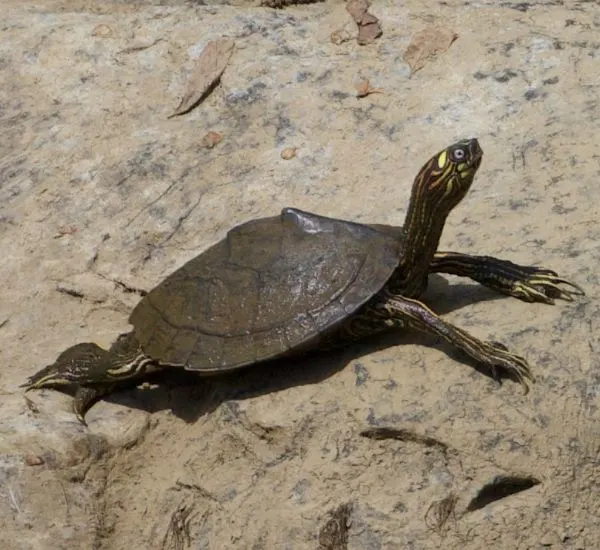
- Experience Level: Beginner
- Family: Emydidae
- Scientific Name: Graptemys ouachitensis
- Other Names: Southern Map turtle
- Adult Size: 3.5 to 10 inches (9 to 25.5 cm)
- Life Span: 15 to 20 years
- Average Price Range: $40 to $100
- Conservation Status: Least concern
Ouachita Map turtles have large yellow or white spots behind and below their eyes. They also have a keel similar to the False Map turtle, only on the Ouachita, the points are more prominent and stick up higher. The eyes on this turtle are usually bright white with a line running through the middle.
These medium sized turtles live in some of the same areas as False Map turtles, but can also be found in smaller streams and fast moving rivers.
They eat the same omnivorous diet as False Map turtles; carrion fish, insects, snails, crayfish, and some vegetation.
Mud Turtles in Missouri
9. Mississippi Mud Turtle

- Experience level: Intermediate
- Family: Kinosternidae
- Scientific Name: Kinosternon subrubrum hippocrepis
- Other Names: N/A
- Average Adult Size: 5 – 7 inches
- Life Span: 25 – 45 years
- Average Price Range: $40 – $80
- Conservation Status: Least Concern
Mississippi Mud turtles are mostly found in swamps, bogs, or marshes in the southeastern area of the state. Mississippi Mud turtles are at home in the water and on land and will spend as much time on land as in the water.
These small turtles have an oval, high domed shell that’s brown, or black, and often covered in mud. They have yellow stripes on the side of the neck and head that may appear spotty in some individuals. The plastron is a muddy yellow color with brown on the outer scutes.
Both mud turtles and musk turtles can excrete an awful smelling musk from glands located at the back of the turtle. They secrete this oily substance to deter predators and curious hands. They will also try to bite if fingers get too close.
In the winter, these turtles will travel nearly half a mile away to burrow into the mud and dirt. They will go up to 6 inches into the soil to protect themselves from hard freezes.
Mississippi Mud turtles are omnivores, feeding on plants, algae, snails, worms, mollusks, fish, and carrion.
10. Yellow Mud Turtle
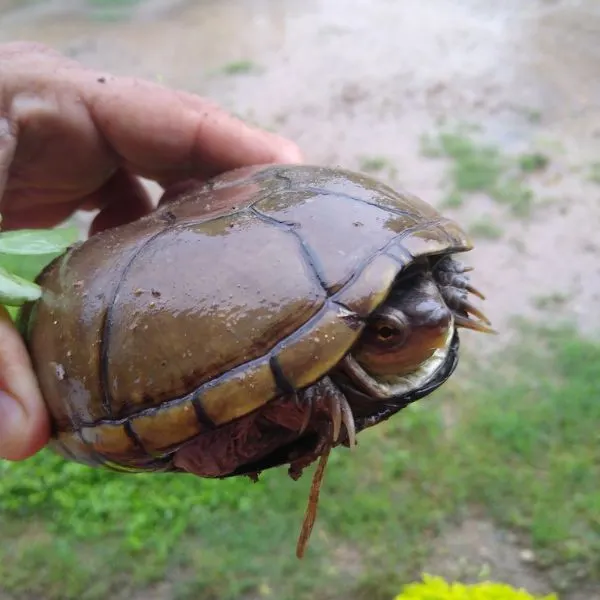
- Experience level: Intermediate
- Family: Kinosternidae
- Scientific Name: Kinosternon flavescens
- Common Name: Mud Turtle, Yellow Mud Turtle
- Average Adult Size: 5 – 7 inches
- Life Span: 40 years
- Average Price Range: Approximately $80 to $300
- Conservation Status: Conservation Status: Federally listed as least concern, but threatened or endangered in most states.
Yellow Mud Turtles are another smaller species similar to the Mississippi Mud turtle. They have a flattened, domed carapace that’s usually olive and patternless. Some may have lighter colored shells. Their plastron is yellowish-brown, and they have a yellow chin and throat.
The tails on these turtles end in a horned, claw-like tip.
The Yellow Mud turtle prefers waters with slow or no current such as marshes, ponds, drainage ditches, and small lakes with sandy, or muddy bottoms. In the winter, they will bury themselves up to 10 inches deep in the mud.
These turtles are a rare find in Missouri and only appear in a select few southwestern counties. In the hot, summer months, the Yellow Mud turtle is more active during the mornings and evenings.
Mostly carnivorous, Yellow Mud turtles eat mollusks, crayfish, invertebrates, and occasionally fish.
Musk Turtles in Missouri
11. Eastern Musk Turtle
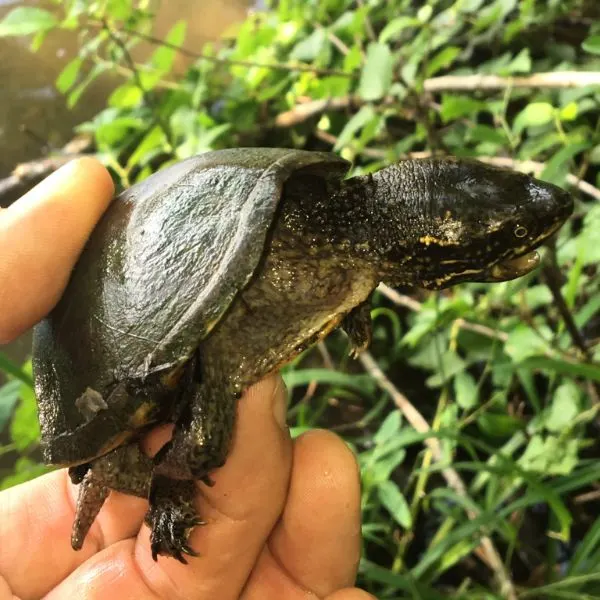
- Experience Level: Intermediate
- Family: Kinosternidae
- Scientific Name: Sternotherus odoratus
- Other Names: Common Musk turtle, Stinkpot
- Adult Size: 4 to 5 inches (10 to 12.5 cm)
- Life Span: 30 to 50 years
- Average Price Range: $30 to $120
- Conservation Status: Least concern
Even though the Eastern Musk turtle is nicknamed the “Stinkpot,” other subspecies of mud and musk turtles have the same odorous defense mechanism. The little stinky Musk turtle is the Show Me State’s smallest turtle. They only top out at 5 to 6 inches long.
Another dark shelled turtle that has no markings on the carapace. These turtles have a pointed head and longer snout. They have a pair of stripes on either side of their head that starts at the nose and can stretch as far back as the body.
Eastern Musk turtles are mostly nocturnal, spending most of the day either in the water or buried in the mud. You can find these turtles in large numbers in reservoirs, lakes, sloughs, oxbows, and rivers.
The Stinkpot isn’t an accomplished swimmer, despite spending a lot of time in the water. They prefer muddy bottomed waters with abundant vegetation. They will search among the bottom and in the plants for food, and to help move around.
Musk turtles are omnivorous, but they tend to eat more meat sources such as crayfish, leeches, tadpoles, fish, and mollusks.
Painted Turtles in Missouri
12. Southern Painted Turtle

- Experience level: Beginner
- Family: Emydidae
- Scientific Name: Chrysemys dorsalis
- Other Names: Painted Turtle
- Average Adult Size: 4 – 6 inches
- Life Span: 20 – 25 years
- Average Price Range: $30 – $150
- Conservation Status: Least Concern
Southern Painted turtles are the smallest subspecies of Painted turtles. They have a smooth, olive, brown, or black carapace with a bright yellow, orange, or red stripe that runs down the middle. The outer edge is also yellow or orange.
The plastron on these turtles is usually tan or yellow and may have a faint, darker smudge along the middle line. You’ll see bright yellow, orange, or red stripes on the skin of these turtles, though the head is mostly only yellow.
Southern Painted turtles like waters with little to no current such as swamps, small streams, oxbow lakes, and the occasional drainage ditch. They need areas with plenty of aquatic plants as adults feed on these plants quite often, but will occasionally eat insects, leeches, and other invertebrates.
13. Western Painted Turtle
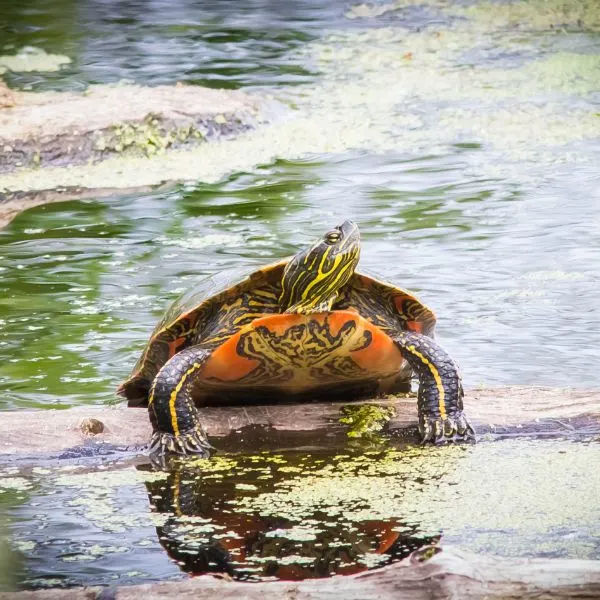
- Experience Level: Beginner
- Family: Emydidae
- Scientific Name: Chrysemys Picta Belli
- Other Names: N/A
- Adult Size: Between 4 and 10 inches
- Life Span: Between 30 and 50 years
- Average Price Range: Between $30 and $150
- Conservation Status: Least concern
Western Painted turtles are larger than their Southern cousins. They have smooth carapaces that are nearly all brown, olive, or black. Their scutes may have a reddish-orange outline. Their plastron is bright orange, or red and has a prominent brown marking that is different for each turtle.
Western Painted turtles prefer waters with slow currents, muddy bottoms, and a lot of plant life. Oxbows, swamps, and marshes fit the bill for these turtles.
Adults feed on more vegetation, while juvenile Painted turtles consume more insects, worms, fish, carrion, and crayfish.
Pond Sliders in Missouri
14. Red Eared Slider
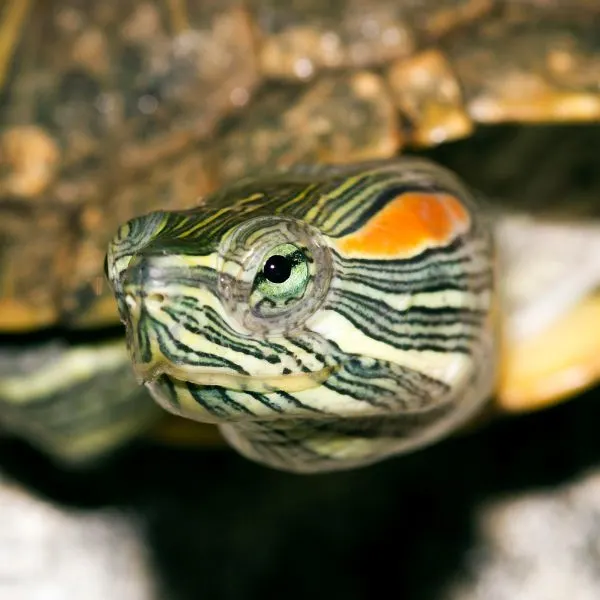
- Experience level: Beginner
- Family: Emydidae
- Scientific Name: Trachemys scripta elegans
- Common Name: Pond slider, Red-eared terrapin, Water slider
- Average Adult Size: 6 – 8 inches
- Life Span: 20 to 40 years
- Average Price Range: approximately $30 to $100
- Conservation Status: Least concern
The Red Eared Slider is one of the most abundant species found in Missouri. They prefer slow moving waters with plenty of vegetation. They reside in lakes, rivers, and man made habitats such as reservoirs.
Red Eared Sliders have ornate upper shells. They are typically olive, or dark brown with abundant yellow, orange, brown, or black stripes. Their plastron is muted yellow, with black or brown spots or smudges on the scutes.
Their skin is dark, and darkens with age, but is broken up with yellow stripes, and elongated red spots on the head, behind the eyes.
Though they are excellent swimmers, they don’t like fast currents and spend a lot of time basking. You’ll often see turtles crowded on top of each other on small outcroppings.
An omnivorous species, the Red Eared Slider will eat nearly anything. This includes aquatic vegetation, insects, fish, tadpoles, worms, leeches, and mollusks.
Snapping Turtles in Missouri
15. Alligator Snapping Turtle

- Experience level: Expert
- Family: Chelydrida
- Scientific Name: Macrochelys temminckii
- Common Name: Loggerhead Snapper
- Average Adult Size: 13-30 inches
- Life Span: 30 – 50 years
- Average Price Range: Approximately $50 to $300
- Conservation Status: Threatened
Alligator Snapping turtles are the largest freshwater turtle species in the United States. With their spiked shells, huge beaky mouths, long spiked tails, and huge limbs, they are instantly recognizable. These turtles look like an animal that time forgot.
They are usually dark brown on the shell and exposed skin, with the underside of the jaw and limbs being lighter in color. They are often covered in mud and algae because of their sedentary lifestyle.
These turtles are rare in Missouri but can be found in deep lakes, reservoirs, rivers, and oxbows. They tend to spend time in root snags, and other hiding spaces during the daylight, and become more active at night.
You don’t have to worry about these turtles while you’re in the water, because they will only get away from disturbances when they are underwater. When they are found on land, their aggressive attitude surfaces.
Males rarely ever leave the water, even to bask. Females will leave the water to find proper nesting sites. If you find an Alligator Snapping turtle on land, just leave it alone and you’ll have nothing to worry about.
Mostly carnivorous, these huge turtles will feed on fish, snakes, frogs, small turtles, other amphibians, and anything they can get in their mouth. They have a fleshy appendage on their tongue they use as a lure.
Alligator Snapping turtles have been observed eating acorns, pecans, and other nuts, as well as persimmon fruits.
16. Common Snapping Turtle
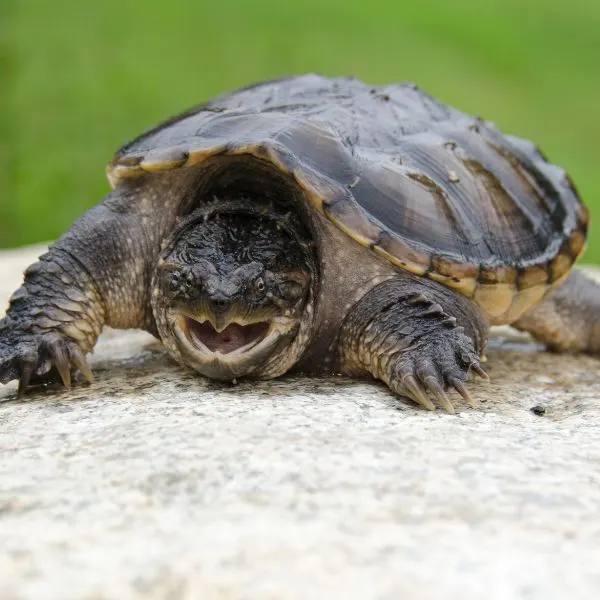
- Experience level: Intermediate to Expert
- Family: Chelydrida
- Scientific Name: Chelydra Serpentina
- Other Names: Snapping Turtle, Snapper, Eastern Snapping Turtle
- Average Adult Size: 8 to 20 inches
- Life Span: 30 – 50 years
- Average Price Range: Approximately $40 to $120
- Conservation Status: Least concern
Common Snapping turtles are smaller cousins to Alligator Snappers. These turtles have a smoother shell, with three ridges near the back. They have a very small, cross-shaped plastron that offers little protection.
You’ll notice the stout limbs, long necks, and bulbous heads on these turtles. While in the water, they are mild and timid, when found on the land they can be frightening. They will hiss, show their wide mouths, and strike like a snake to bite if one gets too close.
Though they rarely leave the water, females will often leave to find better habitats or places to lay their eggs.
Snapping turtles can be found throughout Missouri in a variety of watery habitats. They prefer permanent bodies of water with muddy bottoms so they can bury themselves in the substrate and ambush prey.
These large turtles are omnivores, feeding on fish, carrion, amphibians, small turtles, the occasional small waterfowl, insects, and vegetation.
Softshell Turtles in Missouri
17. Midland Smooth Softshell Turtle

- Experience level: Intermediate
- Family: Trionychidae
- Scientific Name: Apalone Mutica
- Other Names: N/A
- Average Adult Size: 5 – 14 inches
- Life Span: 10 – 20 years
- Average Price Range: $50 – $150
- Conservation Status: Least Concern
The Midland Smooth Softshell turtle is common to many large rivers, lakes, and reservoirs that have sandy or muddy bottoms. These very flattened turtles have a leather, smooth carapace that is typically olive, tan, grey, or dark brown. They can have spots, circles, or dark colored blotches on the shell.
They have a long neck, and an elongated snout they use to reach the surface and breathe without exposing themselves. In sandy substrates, they like to bury themselves and ambush prey.
Midland Smooth Softshell turtles have white, or yellowish stripes on either side of their head that starts at the eye and moves to the neck.
They have very sharp beaks and long claws they use to defend themselves. This species of turtle is an accomplished swimmer, and very swift on land.
Mostly omnivorous, this turtle will eat fish, crayfish, carrion, salamanders, and frogs.
18. Spiny Softshell Turtle
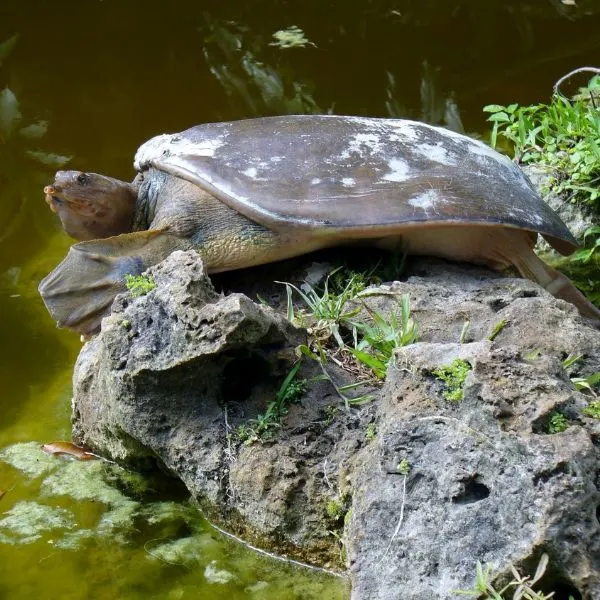
- Experience Level: Intermediate to Expert
- Family: Trionychidae
- Scientific Name: Apalone spinifera
- Other Names: N/A
- Adult Size: 5 to 9 ½ inches for males, 10 to 17 inches for females
- Life Span: Between 20 and 50 years
- Average Price Range: Between $20 and $120
- Conservation Status: Threatened in some areas
Spiny Softshell turtles are very similar in appearance and attitude to Smooth Softshell turtles. The main difference is the bumpy tubercles along the front ridge of the floppy carapace.
Young Spinys and males are olive, or grey on the carapace with small black spots. Females grow darker, and the spots fade as they age.
In most species of Softshell turtles, females are nearly double the size of males.
Since Softshell turtles don’t have the protection of a hard shell, they make up for it by being fast, as well as aggressive. They have a long neck that can reach out farther than most people realize, and will bite or scratch anything that tries to handle them.
These turtles inhabit lakes, rivers, large ponds, and streams as long as they have a soft, sandy bottom.
Mostly carnivorous, Spiny Softshell turtles feed on tadpoles, fish, crayfish, mollusks, frogs, worms, and other small aquatic animals.
Wrapping up
And that wraps up our informative list of the 18 species of turtles that live in Missouri. Most of the turtles in Missouri are protected and can’t be taken from the wild. You can trap a few species, but check the laws to find out, you may need special permits.
If you’re looking for a turtle as a pet, find an adoption agency, or a reputable breeder instead of taking turtles from the wild. When you remove turtles from their natural habitat, you’re damaging the ecosystem and harming the turtle. They don’t do well in captivity unless they’ve been bred into it.
If you enjoyed reading all about Missouri turtles, leave us a comment below and share your thoughts with us and other fellow turtle enthusiasts!
Other nearby states
- Turtles in Arkansas
- Turtles in Illinois
- Turtles in Iowa
- Turtles in Kansas
- Turtles in Kentucky
- Turtles in Nebraska
- Turtles in Oklahoma
- Turtles in Tennessee
